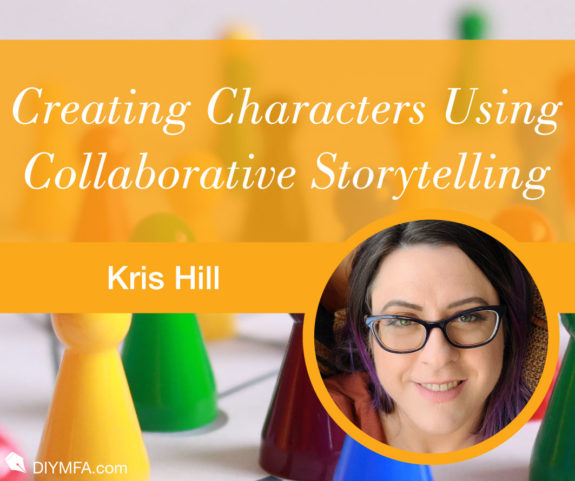Writing may seem like a solitary practice, but writers have made use of writer’s groups and feedback circles for a long time. There is incalculable value in receiving outside input about your writing. Other people can see things about your writing that you may be blind to. However, writers’ groups can only critique the work you’ve written once you’ve written it.
If you want to experiment with parts of your planned story before you commit time to writing it, then collaborative storytelling can help you flex narrative muscles in a low stakes and fun way. Collaborative storytelling also provides a lot of opportunities for writers to work in concert to create something wonderful.
Last time, I discussed how you can use table top games in your world building as a writer. I hope since then you’ve given some thought to making collaborative storytelling a part of your writing practice. If I haven’t sold you on role playing games by explaining how useful it can be in world building, then allow me to present how you can use it when creating characters.
Character Headspace
In most collaborative storytelling games, players will create a character. If you’re a player, you will use one of many methods for character creation such as assigning number values to attributes and skills as in Dungeons and Dragons, assigning descriptive traits to your character and other characters in your group as in FATE system, or by selecting one of many archetypes particular to your setting as in the Powered by the Apocalypse system.
While creating your character, think about the person you want them to be on the page. As you are required to select traits or apply number values to your character, you will have to prioritize what is most important to your character and what they have spent their time doing. You’ll ask yourself questions about how they deal with conflict and how they approach other people. Asking these questions will get you closer to your character and help you work out how they make their decisions, but the best way to get into your character’s headspace is to play as them.
In a collaborative storytelling game, as you play your character, you’ll occupy their headspace and become intimately familiar with not only the choices they make, but how they come to those decisions and how they rationalize the outcome. This level of intimacy with your character makes writing them easier because whatever happens as your story unfolds, you’ll know how they would approach it.
This works well even if the setting that you’re playing in differs vastly from the setting of your story because decision making, rationalization, and prioritization are deeply rooted in who your character is as a person. You can apply that deeper personality to your character in any setting.
Character Relationships
Collaborative storytelling games involve a party of characters, and you’ll be playing as only one of them. The friends you’re playing with will make their own characters and you’ll work together to solve problems. It is valuable for you to experience how your character interacts with others, and party members are especially useful to explore relationships because they will be the people your character interacts with most.
As your party moves through the game together you’ll decide how your character works in a group, how they collaborate to solve problems, and how they argue or debate to defend their positions against people they must continue to be around. You’ll see what qualities they value in their party members and how they form friendships and develop trust.
I think the most valuable part of character development using party interaction in a collaborative storytelling game is that you’ll see how your friends and their characters perceive the character you’re creating. This is helpful because it will allow you to fine tune your character.
Maybe you want to create a sneaky thief with a heart of gold, but you cross a line that makes your party see you as irredeemable or evil. When you’re writing your story, you’ll know that you will need to pay particular attention to explain those types of decisions carefully to your readers.
Perhaps you want to make a principled and stalwart character who is lovable and vulnerable, but your party members only see one side of your character. You then know that you need to do more to illustrate the fullness of the character you’re trying to portray.
Regardless of the character you create, the perception of that character from other party members is priceless feedback you can use to bring the truest version of your vision to life.
NPCs
Non-Player Characters (NPCs) are plentiful in role playing games. The friendly bartender, the cagey espionage contact, and the wise mentor are all NPCs. Though you may not realize it, there are NPCs in your story as well. The minor characters who flesh out your world and make it seem lived in, but aren’t important to the plot in a major way, are your NPCs. These characters don’t require as much development as major players in your story, but the more interesting they are during their short time in your story, the better.
If you are running a campaign for your friends to play you’ll need to populate your world with people for the party to interact with. You can see which NPCs capture the party’s attention most and you will be able to tell why. You’ll also get an opportunity to see how many different characters interact with your minor characters as player characters will have different styles and personalities. Getting to see your minor characters in these different situations will help you craft memorable characters and natural dialogue in your writing.
I hope that I’ve inspired you to try collective storytelling in your writing practice. I wish you much success in your writing, but not on your role playing adventures because failure is usually more fun!

Kris Hill is working on several genre fiction novels because she has difficulty sticking to writing one project at a time. In her daily life she attempts to navigate the corporate world as a data analyst. When Kris is not working, she can be found sprawled on a couch reading or running tabletop adventures for her friends. She lives in Canada’s capital city with her husband, her best friend, and four cats.







